This was published 6 years ago
Myanmar's hidden wine industry: Worth bottling
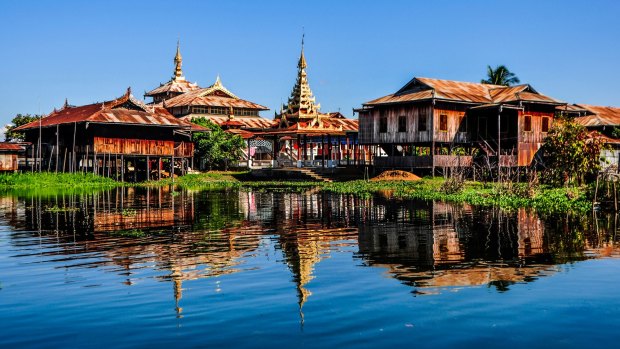
Inle Lake.Credit: iStock
A Burmese woman, her face adorned in traditional yellow paste, strides down the rows of shiraz as the hot Myanmar sun beats down. Suddenly she stops, crouches down, and inspects a tiny bunch of green grapes.
In a few months, they'll be plucked from these vines and transformed into wine for locals, tourists and overseas drinkers.
The scene highlights the dizzying changes that have unfolded in Myanmar, a country now open for business after half a century of military rule.
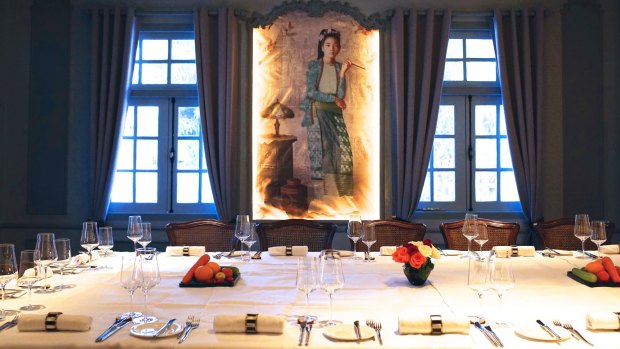
A private room at Le Planteur.
The Asian nation's first winery, Aythaya Vineyard in Shan state in north-eastern Myanmar, could be mistaken for the Napa Valley or Barossa.
"The people are starting to drink wine," head winemaker Hans-Eduard Leiendecker says. "We are a free country now."
It's his job to make people drink. And I'm happy to help out. The tasting session is at the vineyard's Sunset WineGarden restaurant, an airy venue with no walls, a towering jackfruit laden with spiky, alien-looking fruit, and impressive views of the Shan Hills.
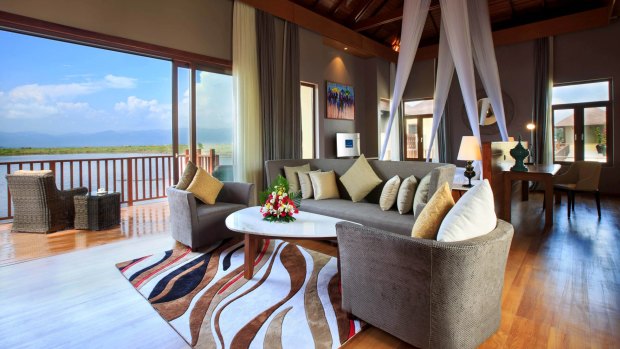
Novotel Inle Myat Min.
I start with the sparkling rosé, and move through to the shiraz, tempranillo and sauvignon blanc. The late-harvest sauvignon blanc is my favourite – a full-bodied, fruity variety that goes down nicely in hot weather.
Mynamar's wine culture is still in its infancy, and there are only two wineries in the entire country. But business is picking up thanks to a growing middle class and a boom in tourism.
The winery produced 200,000 bottles this year, and Leiendecker has plans to expand.
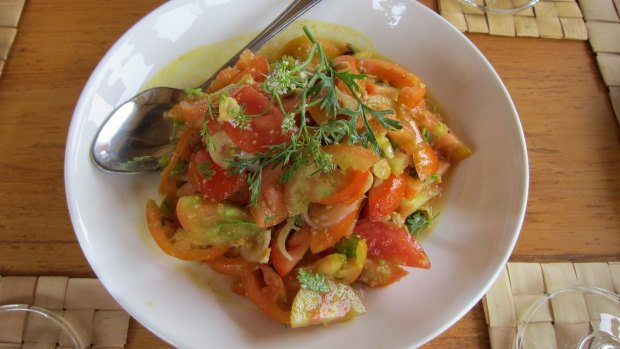
Green chilli tomato salad.
In a country of 52 million people, the potential is huge. He tells me that a head,, the Burmese drink just one tenth of a glass of wine every year. Australians look like guzzlers in comparison, with the average person downing 3.6 litres of plonk annually.
But Leiendecker says the Burmese are not accustomed to drinking wine. Some locals assume it is like beer, polish off an entire bottle, and find themselves unpleasantly drunk.
The winery is hoping to change that, and has been educating bars and hotels on how to serve wine, and what food to pair it with.
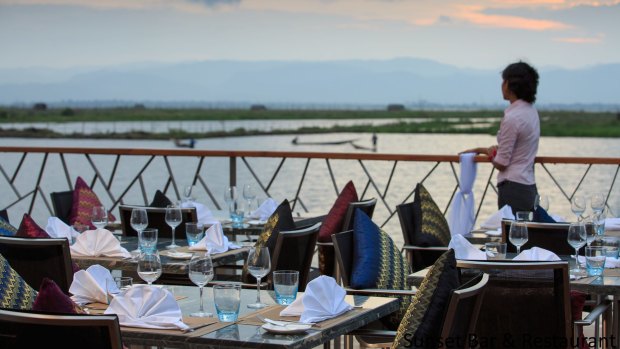
The view from Novotel Inle Myat Min, Myanmar.
We order too much food to accompany our wine – but that's not a problem. The chicken with basil, mutton with lime and seaweed and tomato salad are superb. Like many of the local dishes, it is spicy, sour and sweet. Myanmar is a melting pot of flavours, with its cuisine influenced by its neighbours India, Thailand and China.
After lunch we travel south to the Novotel Inle Lake, watching the landscape change from a dry patchwork of browns, to a lush, tropical setting.
The roads are narrow, dusty, and full of life. Couples whiz past on scooters, buffalos with huge black horns haul wooden carts and families sell soft drinks and bags of Heho potato crisps from the side of the road.
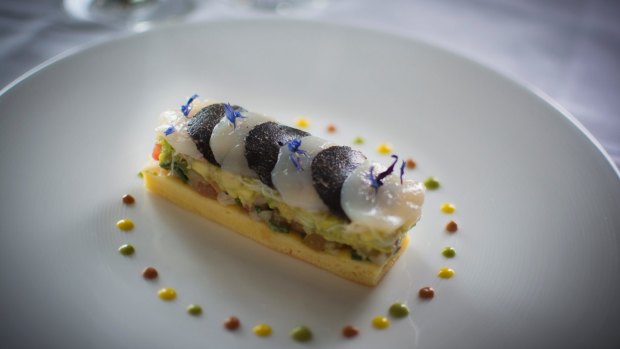
Carpaccio scallops at Le Planteur Restaurants & Lounge.
We arrive at our hotel and are immediately greeted with smiles, damp wash clothes and an iced lemon and mint drink.
The sprawling Inle Lake is the perfect place to discover Myanmar's distinct Shan cuisine.
I'm staying in a spacious villa on stilts overlooking the lake. There's a balcony, a bath shaped like a giant egg and the most comfortable bed I've ever slept on, which is encased in mosquito nets. This place feels like a dream. As the sun prepares to set, there's a mad rush to the appropriately named Sunset bar. It sits on the lake's eastern edge and serves an impressive range of cocktails. The service is impeccable, and before I've even had time to order my drink, a small plate of popped rice cakes and spicy tomato dipping sauce appears. I settle on a mojito and lean back to watch the show.
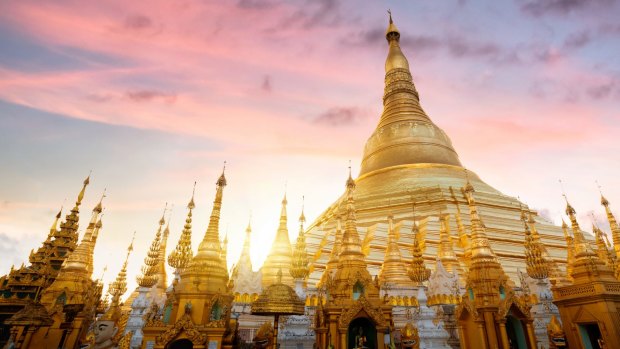
Shwedagon Pagoda at sunset, Yangon.Credit: iStock
Oranges, pinks and reds swirl around the glowing sun, as it sinks behind the hills over the lake.
I'm introduced to the local cuisine at the hotel's Terrace Restaurant. I tuck into the Shan set menu, a great option for indecisive people who want to try everything. It's served in a large resin dish which is divided into segments overflowing with deep fried yellow tofu, stuffed fish with tamarind dip, chicken and marrow stew, steamed butterfish in banana leaves and stir-fried watercress. The hotel's revenue manager, Stephen Yong, says that before setting up on the picturesque lake, Novotel management went to great lengths to get the community on board. Striking up a relationship with farmers, and bonding over food was one way of achieving this. The hotel lets locals farm on its land for free. The restaurant kitchen then buys their produce for a good price.
"We want to keep the nature, develop, and give back to the community," Yong says.
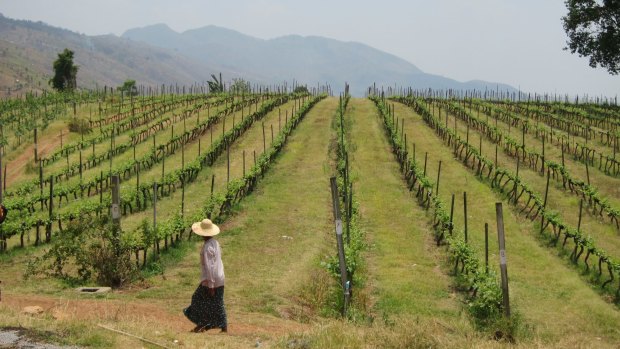
Aythaya Vineyard in north-eastern Myanmar.
The next morning I clamber onto a long teak boat with a motor and drift through the vast Inle Lake, which stretches 22 kilometres. It's here that the Intha people live. Fishermen row with a unique technique, locking the oar between the back of their knee and foot. Dragonflies skit across the water as the fishermen unfurl their nets. Farmers lovingly tend to tomatoes and cucumber growing on stakes in the sprawling floating gardens. Soon, I'll be eating these same tomatoes at the Green Chilli Restaurant in Nampan Village.
The restaurant is off the beaten track, inside a colonial-style building on stilts. We moor our boat at the entrance, and plonk ourselves on the verandah. It overlooks the lake, wooden houses and a poinciana tree bursting with red flowers. Green Chilli serves Burmese and Thai food and sources all its ingredients locally. We order the "trouble fish" which was caught just hours earlier, in the waters below. It has a subtle taste and is gently fried and topped with ginger, tomato and onion. The smiling waiter brings out what seems like an endless stream of delicious dishes. There's green tomato salad, tofu curry, a fish soup, and smoky eggplant with peanuts. The eggplant dish tastes a little bit like baba ghanoush, but is fresher, and less oily. Dessert is banana cake and fruit. This is one of the best meals I have ever eaten.
Another day, another sunset. This time at Red Mountain Estate, which is nestled in the hills in the Inle Lake region. I wasn't too impressed by the wine – a bit too pungent for my tastebuds – but the sunset blew me away. Tourists snack on fried chicken and chat about their travels in the al fresco dining area which looks out over the valley to the lake.
My next culinary stop is Yangon – the former capital of Myanmar. I put on heels and a dress and head along to what is considered one of the city's finest restaurants – Le Planteur. The upmarket French restaurant is set in a colonial-style mansion with a manicured garden, which looks out onto a lake. The mansion is surrounded by monasteries, so it's quiet. It doesn't feel like we are in a bustling city of 5.2 million people – you can't even hear the traffic. Aung San Suu Kyi lives nearby and it's rumoured that the First Lady visits the restaurant regularly.
Diners can either sit inside, or under the stars on the restaurant's manicured lawn. We choose the latter, and it's the perfect night for it. It's a very romantic setting and reminds me of The Great Gatsby. Candles light up our plates, revealing a series of intricate and delicious dishes. Carpaccio scallops are served on a parmesan biscuit with wasabi ice-cream, foie gras is perched on a bed of mushrooms with truffle oil and the snow fish fillet is cooked in a herby crust and served with a delicate prawn raviole and coriander foam. Desert is a black chocolate dome with passion fruit and a tonka bean biscuit. This is the sort of food you'd never be able to replicate at home.
My tour group ticks off another Yangon drinking highlight the following day – the Strand Hotel. The grand Victorian-style building was built by the Sarkies brother when Myanmar was a British colony, and opened in 1901. We sit at the wooden bar, and order the most popular cocktail on the menu, the Strand Sour. Bartenders in black vests serve more than 100 of these drinks every day, shaking the lime juice, Mandalay rum and sugar syrup to a secret rhythm.
It looks like a place that is mainly frequented by expats, hotel guests and tourists, but it's definitely worth a visit. It has an old-world charm, and Rudyard Kipling once stayed here.
The golden afternoon sun streams through the tall teak windows of the Strand. We realise it is about to set and we need to get to the Shwedagon Pagoda – the most sacred Buddhist site in Myanmar – before the giant gold mass is cloaked in darkness. But not before finishing our drink. Every last drop.
TRIP NOTES
MORE
FLY
Scoot flies from Melbourne, Sydney, the Gold Coast and Perth to Singapore with Tigerair providing connections to Yangon. See flyscoot.com or tigerair.com.sg
VISA
Australians travelling to Myanmar need a visa. See evisa.moip.gov.mm
Henrietta Cook was a guest of Accor Hotels, Novotel Yangon Max and Novotel Inle Lake, Scoot and Tigerair.
Sign up for the Traveller Deals newsletter
Get exclusive travel deals delivered straight to your inbox. Sign up now.